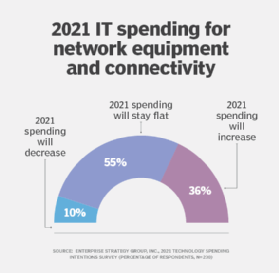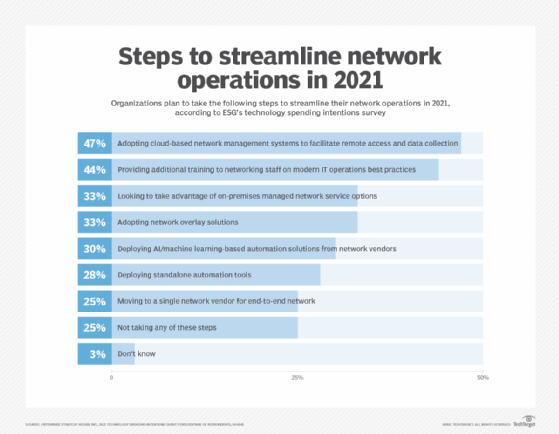
Getty Images/iStockphoto
Cloud-based network management leads 2021 network investments
A recent ESG survey shows that many enterprises speeding their digital transformation plans are also increasing 2021 network investment, emphasizing cloud-based network management.
Enterprises accelerating their digital transformation plans are making network investments at higher levels this year, with particular emphasis on cloud-based network management and automation systems to drive network optimization and efficiency, according to a recent survey by Enterprise Strategy Group, a division of TechTarget.
Many companies speeded their digital transformation projects due to the move to remote work in the last year. While some projections indicated the global pandemic would slow enterprise IT investment overall, ESG's "2021 Technology Spending Intentions Survey" revealed a majority of organizations increased their 2021 IT budgets, and more than a third said they would increase their network spending, according to ESG senior analyst Bob Laliberte. According to the survey, the two biggest network investments will be in cloud-based network management systems and staff training in modern IT operations best practices.
ESG completed its 2021 spending survey in January, with results from 664 senior IT decision-makers at midsize and large enterprises across North America and Western Europe. Respondents with purchasing influence or authority for networking products and services also were asked about their organizations' spending plans over the next 12 months.
While 36% said they plan to increase spending on network equipment and connectivity compared to last year, 55% of respondents reported network spending will remain flat. Laliberte noted that network spending already makes up a large percentage of IT budgets. But, for many organizations, network spending priorities are shifting, especially as the workforce becomes more distributed.

Streamlining network operations
Because modern IT environments are becoming more highly distributed and complex, ESG asked respondents to identify what actions they plan to take to streamline network operations. Almost half (47%) of all respondents are focused on cloud-based network management systems to facilitate remote access and data collection as their primary initiative. Providing networking staff with additional training on modern IT operations best practices ranked second at 44%.
Additional steps organizations plan to take to streamline network operations also include the following:
- taking advantage of on-premises managed network service operations;
- adopting network overlays;
- deploying AI/machine learning-based automation systems from network vendors;
- deploying standalone automation tools; and
- moving to a single end-to-end network vendor.

Benefits of cloud-based network management
With a geographically dispersed workforce, moving to cloud-based network management systems has multiple advantages, according to Laliberte.
First, a cloud-based system can be easily accessed from anywhere. It also eliminates the need for IT teams to manage infrastructure on the organization's premises, enabling them to eliminate lifecycle management tasks that include manual upgrades and scheduled hardware and software maintenance windows.
 Bob Laliberte
Bob Laliberte
Instead, many of the advanced cloud platforms are cloud-native, offering built-in upgrades that are delivered directly to the customer every few months. "With a cloud-based system, that's all taken care of on the back end by the vendor," Laliberte said.
The data collected from a cloud-based system also enables organizations to take advantages of AI and machine learning. Those data sets can create algorithms that support self-healing, self-optimizing network management, Laliberte said.
"The result is that having a cloud-based network management system can drive operational efficiency in a much larger area of connectivity," he added.
Distributed workforce meets operational efficiency
With the work-from-home effort tied to the global pandemic, the enterprise networking mandate is to connect all employees to corporate data centers and multiple clouds instead of just connecting branch offices, campuses and corporate locations to those applications.
As organizations moved to modern networking technology to support the increasing distributed workforce, many saw gains in operational efficiencies.
Before the pandemic, ESG research indicated 7% to 15% of knowledge workers worked from home full time. That percentage soared to 76% in North America when the pandemic hit, and the number has now dropped to about 56%, with many returning to work in a hybrid remote/in-office model, Laliberte added. But it's still a significant number of people working remotely, and organizations need continued support for those workers.
At the beginning of the pandemic, organizations expanded VPN concentrators and licenses and bought more load balancers and firewalls. But the rapid increase of distributed traffic put more stress on the data center, and organizations realized they needed long-term answers for the complex distributed network access model that emerged.
As a result, enterprises invested in WAN upgrades and integration with cloud vendors to tap into those vendors' network backbones and improve performance from one location to the other, Laliberte said. He also said he sees more efforts to extend access points (APs) or deploy software-defined WAN (SD-WAN) to remote users so they can go directly to the internet from wherever they're located.
The shift to SD-WAN also enables enterprises to convert expensive bandwidth-limited MPLS links to low-cost, high-bandwidth broadband connections, he added. Enterprises can use those cost savings to purchase APs for remote workers and invest in other ways to extend the corporate LAN to the home.
Another shift is the growing reliance on network services, best illustrated by consuming SD-WAN as a managed service. Other networking vendors are also offering network-as-a-service options managed on the organization's premises or in the cloud. The past year flipped from the old Capex model to more of a subscription-based as-a-service model, Laliberte added, which provides more flexibility and business resiliency.
Business resilience extends geographical boundaries
A new focus on business resiliency means organizations want to make sure their knowledge workers will be able to work effectively from home or an office.
Following 9/11, having multiple data centers and adopting best practices became a business continuity and disaster recovery board-level and executive mandate. The global pandemic is having a similar effect, Laliberte said, in that organizations have shifted to a new norm, and being able to stay open but send employees home needs to be part of the playbook.







